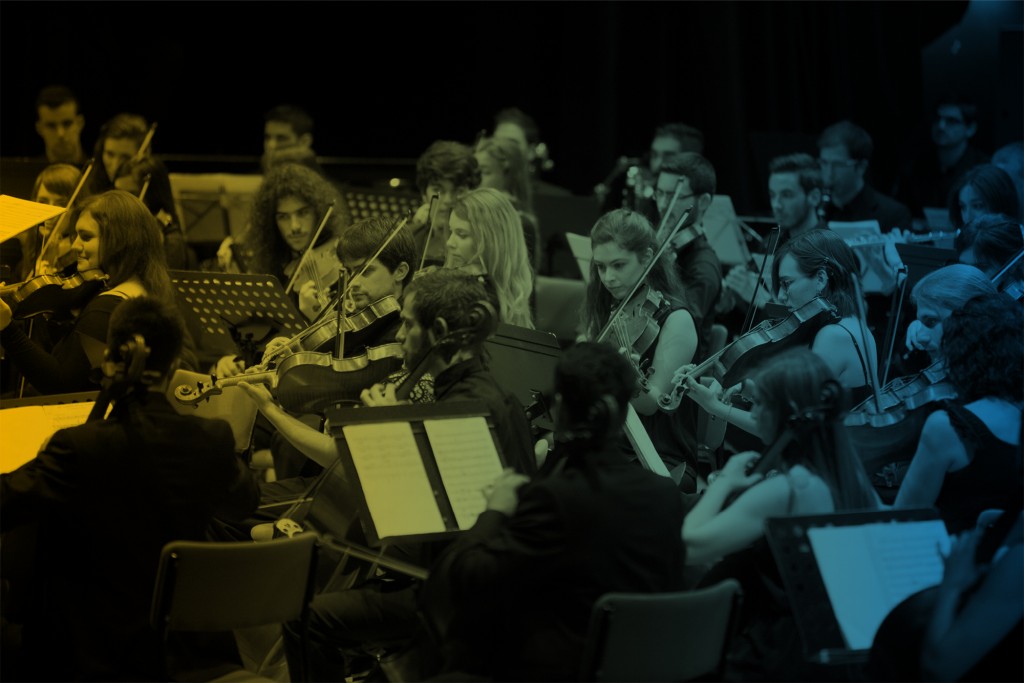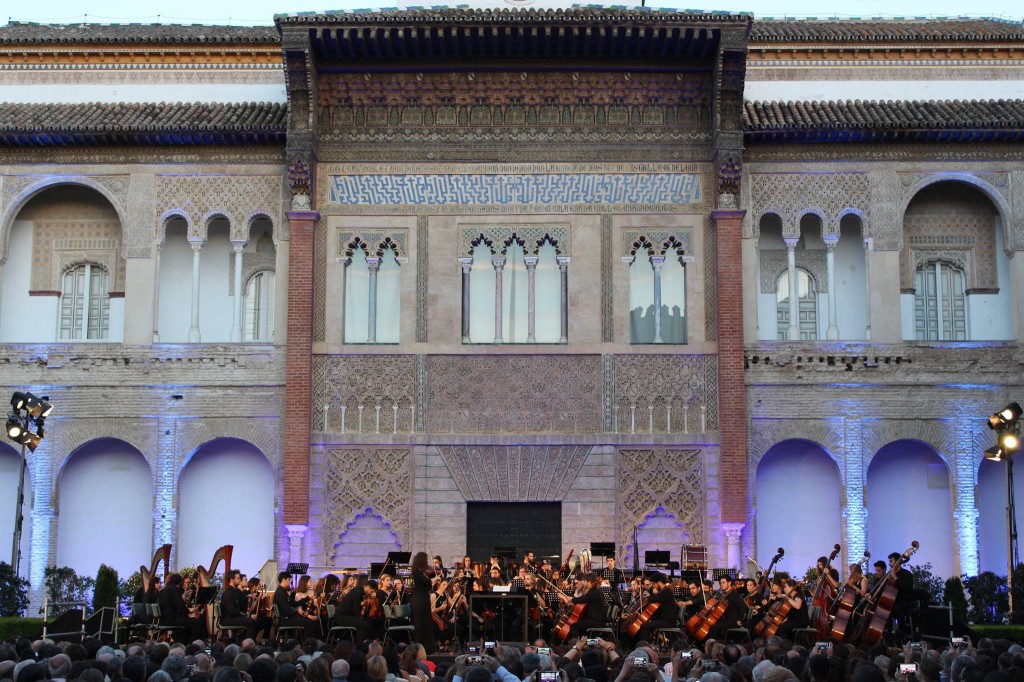OSC ORCHESTRA
An academic and artistic project of the
University of Seville and the Conservatory of Music Manuel Castillo
At the end of 2011, the signing of an agreement between the two institutions closed a series of agreements and collaborations ongoing over the years, with the creation of the Orquesta Sinfónica Conjunta -the Joint Symphony Orchestra- (OSC) of the University of Seville and the Conservatory of Music Manuel Castillo. We were convinced that by joining forces and sharing resources, we could make this thrilling project a reality.
Since its foundation, the OSC has been both artistic and academic in nature, and it operates under a System of Encounters, which has proved to be the most effective within the large young orchestral groups, as well as in the orchestras of the most prestigious Music Universities. It was created with the solid intention of attending to the most demanding audiences, while at the same time meeting the educational needs of the young music students of both institutions.
The annual programme aims to tackle a repertoire as complex and interesting as the symphonic repertoire of the 19th and 20th centuries. These young musicians - future professionals - take on the responsibility each season of displaying their interpretative skills and performance progress to the public and the critics.
Occasionally, and depending on the nature of each concert and the artistic needs, some "reinforcements" (soloists, conductors, singers...) are added to the orchestra.
We work day by day, season by season, so that this initiative delivers the results we all hope for, providing the best possible training for the students and promoting the musical life of Seville and Andalusia.

OSC - LIFE COURSE
In 2011 the University of Seville and the CSM Manuel Castillo launched an ambitious academic and artistic project with the creation of a joint symphony orchestra. Since then, there have been different stages in Seville where it has performed, both in spaces of the University of Seville - auditorium of the ETS of Engineering, Campus Reina Mercedes of the US, ETS of Architecture - and in the main stages of Seville, such as the Teatro Lope de Vega - on a first occasion with its own production of the opera Così fan tutte by Mozart, performed in collaboration with the Fryderyk Chopin University of Music in Warsaw, and on a second occasion with the contemporary opera project "Buscando al Rey.The Voice of the Excluded", with stage direction by Michal Znaniecki, and developed in collaboration with the Polish Institute of Culture, ICAS and ASAO,Teatro de la Maestranza (in the zarzuela production Entre Sevilla y Triana by Sorozábal in 2013, El Retablo de Maese Pedro by Falla in collaboration with ESAD, as well as in the successful concert The Bernstein Beat within the ROSS concert season program, under the baton of J.Axelrod, and the closing concerts of the US 2020-21 and 2022-23), Patio de la Montería del Real Alcázar (also under the direction of J.Axelrod, in a project carried out in collaboration with the UNIA and the students of the Master in Music Performance of the Barenboim-Said Foundation), as well as in the Teatro Central with a spectacular concert of winds and percussion conducted by Camilo Irizo. Outside Seville, it is also worth mentioning its performances in Cadiz, within the framework of the bicentenary celebrations of its Constitution, as well as in Granada within the framework of the Atalaya project, and in Seville province in Carmona, Fuentes de Andalucía, Mairena del Aljarafe or San José de la Rinconada.
The repertoire performed has ranged from classical music to contemporary works by American and European composers such as F. Busoni, A. Copland, J. Adams, A. Pärt, A. Honegger, P. Hindemith, K. Weill, D. Milhaud, A. Webern, H. Tomasi, J. Sibelius. Weill, D. Milhaud, A. Webern, H. Tomasi, J. Sibelius, as well as Spanish-Americans such as L. Brouwer, A. Ginastera or the Spaniards C. Halffter, C. Camarero, M. Castillo, J. A. Pedrosa, J. Rodríguez Romero and A. Flores. Film music has also been present with the interpretation of works by B. Herrmann and L. Bernstein. Bernstein, as well as the world premiere of Entreacto y luz magenta by the National Music Prize winner César Camarero.
Juan García Rodríguez is the principal conductor of the OSC since its foundation, having also participated with maestros such as John Axelrod, Jan Miłosz Zarzycki, Wolfgang Kurz, Cosimo Colazzo, Juan Rodríguez Romero and Camilo Irizo.
The OSC has been a member of the European Network of University Orchestras since 2014 and has been part of the Andalusian Network of University Music Ensembles of the Atalaya Project since 2017.

OSC. KEYS AND SINGULARITIES OF THE US-CSMS JOINT SYMPHONY ORCHESTRA
- YOUTH of its staff, whose members receive specialized, artistic and human training. The orchestra and its projection through a concert season is a highly effective tool as a public instrument to be able to visualize the work and evolution of the students' interpretative skills, as well as the evolution of their interpretative abilities. The orchestra and its projection through a concert season is a highly effective tool as a public instrument to visualize the work and evolution of the interpretative skills of the students, as well as of the group itself, becoming at the same time a great platform for the promotion of young values. Among all these students in training, even the most experienced perform as SOLOISTS in some of the programmed concerts. The formative work has been intense, even extending at some point to the conducting students through workshops, who have been encouraged by the confidence and security transmitted by the principal conductor Juan García. Likewise, in this formative work, students and alumni members of the CSO have participated sporadically in the different stages of production, some of them are currently in the process of recording what would be the first contribution in the edition of a CD and we hope to be published in the last quarter of 2023.
-INTERDISCIPLINARY PROJECTS. Opera, puppet theater, social theater, cinema..., artistic disciplines with which the CSO has worked, and which have brought new experiences and new levels of awareness to the students; in theaters or outdoors (experiencing the difficulties of the wind for score reading, environmental acoustic or light intrusions...), on stage or in the pit (exploring novel situations such as working in semi-darkness and with a direction that is not focused on the stage or in the pit), on stage or in the orchestra pit (exploring novel situations such as working in practical semi-darkness and with a direction that is not focused on the stage). ), on stage or in the pit (exploring novel situations such as working in semi-darkness and with a direction not exclusively dedicated to the group, but simultaneously split between two planes, on stage and in the pit). A new framework, a new aesthetic and experiential dimension that invites the student to deepen, reflect and assimilate new meanings and dimensions of music.
-COMMITMENT TO THE PRESENT DAY. In addition to the classical repertoire, performed widely and by large ensembles on numerous occasions -as has been the case with the interpretation of symphonies by Bruckner or Mahler-, a contemporary repertoire is added, generally unknown to the general public and with which the CSO has sought to fill the void generated by the absence of other institutions in their programming; The CSO thus shows itself as a bastion or vindictive icon of the present, with a strong commitment to the dissemination of new artistic visions, even being the protagonist of world premieres -works by composers such as César Camarero, national music prize winner- or national premieres -with works as acclaimed as little performed as América Mágica by Ginastera or Grand Pianola Music by John Adams-. This hard work has been widely applauded by professionals in the field of musical creation -recall the reflections expressed by the national music prize winners Cristóbal Halffter or César Camarero- and part of the specialized music critics, who have especially praised this facet of the orchestra's dissemination and commitment to new times and aesthetics. This work of diffusion has not stopped here, and we have seen one more aspect of its work of diffusion in projects of RECOVERY OF ANDALUSIAN MUSICAL HERITAGE, playing the Overture of the Queen Regent by Fernando Palatín, in a meeting of such symbolic institutional value and of such projection as the Opening Concert of the 2019-20 academic year at the University of Seville
- INTERNATIONAL DIMENSION of the project, developing ambitious own productions with other institutions such as the Fryderyck Chopin University of Music in Warsaw (Opera Così fan tutte), performing a wide and varied repertoire of European and American composers of all origins and styles. Likewise, several conductors from other countries have been invited to conduct the orchestra occasionally in some of its seasonal concerts, and also numerous students from other countries with international study programs such as Erasmus, thus establishing the CSO as a catalyst structure for young European values and providing institutional prestige to those it represents -University of Seville and CSM Manuel Castillo- for the public service it promotes, associated with values such as academic excellence and its international projection and visibility. The CSO is also a member of the European Network of University Orchestras, ENUO.
-MULTIPLICITY OF SCENARIOS. The main venues have been university venues -mainly the ETS de Ingeniería-, but also auditoriums as important as the Teatro de la Maestranza or Teatro Lope de Vega, either as a consequence of the natural development of the CSO's own concert season or contributing to the achievement of programs of other cultural institutions such as those of the aforementioned theaters or musical institutions such as the ROSS (such has been the case of the CSO's participation in the tribute concerts on the Bernstein anniversary). The creation and maintenance of a symphony orchestra inevitably requires human and material resources - it requires a minimum budget for its own existence and a sufficiently large space in which to develop both the concert and the unavoidable tutti rehearsals, the latter being the moment in which the work is truly being built and where the balance and coordination of the different actions of the students becomes more necessary. Precisely because of this last aspect, the CSO would like to thank other institutions (Fibes, Factoría Cultural...) and faculties or schools (ETS de Arquitectura, ETS de Ingeniería, BBAA and Iglesia de la Anunciación...) for having been especially sensitive to the development of this youth symphony orchestra project, even showing their solidarity and commitment in the development of this project in times as complex as those resulting from government-imposed health crises and consequent administrative difficulties.
-COLLABORATIONS. In addition to the collaborations with other institutions for the celebration of CSO rehearsals and concerts, there are also collaborations in the development of certain projects that generally, due to their interest, complexity or nature, have required alliances, generally with educational groups -students of the ESAD or the Barenboim Saïd Foundation-, Andalusian university orchestras integrated in the Atalaya Project, such as Jaén or Granada; choirs such as the Manuel de Falla, Manuel Castillo, Ateneo de Sevilla and Escolanía Escolanía de Granada; Andalusian university orchestras integrated in the Atalaya Project, such as those of Jaén or Granada; choirs such as those of Manuel de Falla, Manuel Castillo, Ateneo de Sevilla and Escolanía Regina Coeli de Dos Hermanas-, but also with professional groups such as Zahir Ensemble or great soloists such as Óscar Martín or the internationally renowned soprano Natalia Labourdette.
MILESTONES. Development of key moments in the orchestra's trajectory that give an idea of its dimension.